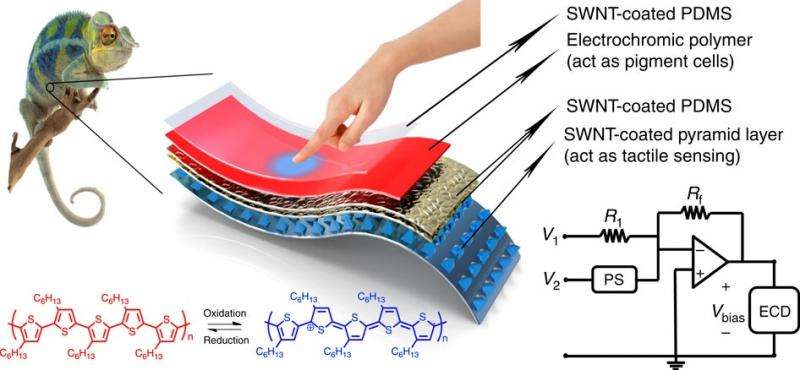The chameleon-inspired e-skin’s two main components are a pressure-sensitive polymer (“pyramid layer”) and an electrochromic polymer. At bottom left, the two chemical structures of the electrochromic polymer are shown that emit red and blue light, respectively. (Ambanja panther chameleon and hand images from 123rf.com) Credit: Chou, et al. ©2015 Macmillan Publishers Limited
(Phys.org)—Researchers at Stanford University have fabricated a stretchable, color-changing, pressure-sensitive material–basically the closest thing yet to an artificial chameleon skin. Touching the new electronic skin (e-skin) with varying amounts of pressure causes it to change colors, as the pressure indirectly alters the chemical structure, and subsequently the optical properties, of the "electrochromic" material. The e-skin could have applications in interactive wearable devices, artificial prosthetics, and smart robots.
Previously, similar materials have been fabricated that can change color, and a few of these are even touch-sensitive, but so far none has also been stretchable. The new e-skin combines all three of these properties for the first time.
"We show an all-solution processed chameleon-inspired stretchable electronic skin (e-skin), in which the e-skin color can easily be controlled through varying the applied pressure along with the applied pressure duration," Ho-Hsiu Chou of Stanford University, who is first author of the study, told Phys.org. "As such, the e-skin's color change can also in turn be utilized to distinguish the pressure applied."
The e-skin consists of two main components: a stretchable microstructured polymer that can modify its voltage upon an applied pressure, and a stretchable electrochromic polymer that can be either red or blue, depending on the applied voltage.
The researchers demonstrated how the e-skin works by using an item not commonly found in most engineering labs: a teddy bear. They attached the pressure-sensitive polymer to the bear's paw, and connected it to the electrochromic polymer which they mounted on the bear's abdomen. The electrochromic polymer first appears red, but after giving the bear a weak handshake (about 50 kilopascals [kPa] of pressure) it turns blue-gray. Once the handshake is removed, the polymer again turns red, but a stronger handshake (about 200 kPa) causes it to turn pale blue.
What's happening, as the researchers explain, is a multi-step process that ultimately changes the chemical structure of the electrochromic polymer into a different chemical structure that emits light at a different wavelength, or color. Pressure from the handshake causes a drop in the electrical resistance of the pressure-sensitive polymer (which is connected to a low-voltage power supply) by up to several orders of magnitude. The drop in resistance increases the voltage to the electrochromic polymer and oxidizes the material, slightly altering its chemical structure. Although the structural change is small, it causes a large change in the material's light absorption spectrum, which can be quickly reversed by releasing the pressure.
When attached to a teddy bear, the e-skin changes color upon a handshake, since the pressure-sensitive polymer is attached to the paw. Credit: Chou, et al. ©2015 Macmillan Publishers Limited
While the electrochromic polymer used here can only switch between shades of red and blue, the researchers expect that other electrochromic polymers can be designed to exhibit a wide range of colors that can be modulated by various pressures. This could lead to a wide variety of applications.
"The e-skin can potentially be integrated into the things that we wear and carry, i.e., clothes, smart phones, smart watches, and any other kind of wearable devices," Chou said. "By integrating with this color-changeable e-skin, you can imagine that all the colors can be integrated into one device, and the user can change it interactively for decoration or to express emotion.
"Because the e-skin's color change can also be in turn utilized to distinguish and quantify the magnitude of pressure we applied, the other potential application is that we can integrate the system into any surface where we want to know the magnitude of pressure applied on it. Also, the e-skin can provide the camouflage function for prosthetics and smart robots. In addition, the stretchable system allows it to attach on curvilinear or dynamic surfaces well, while conventional rigid devices cannot. This advantage can reduce the interface between the device and human body."
As the e-skin has the potential to find use in a wide variety of consumer applications, the researchers addressed the fact that the material contains carbon nanotubes, which have raised concerns about toxicity and carcinogenicity because they have similar shapes as asbestos. Here, the carbon nanotubes are sprayed onto the pressure-sensitive polymer and play an important role in controlling the resistance response to pressure. Fortunately, the carbon nanotubes used here are relatively short and small in diameter, whereas studies have shown that longer and thicker carbon nanotubes induce more DNA damage and inflammation. Still, the researchers recommend that the system be encapsulated in stretchable materials, such as silicone, as a safety precaution.
"Another important target is to make the whole system biodegradable since the device is applied on the human," Chou said.
More information: Ho-Hsiu Chou, et al. "A chameleon-inspired stretchable electronic skin with interactive colour changing controlled by tactile sensing." Nature Communications. DOI: 10.1038/ncomms9011
Journal information: Nature Communications
© 2015 Phys.org
























